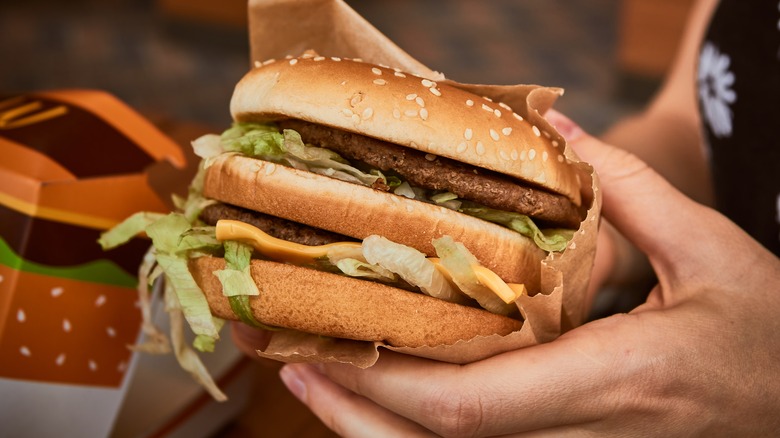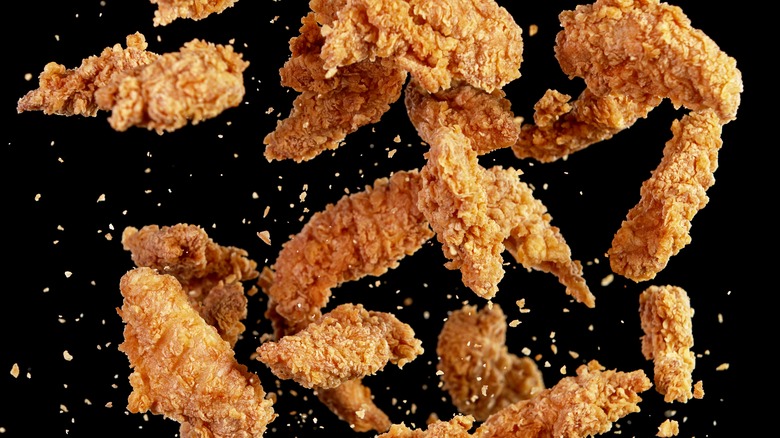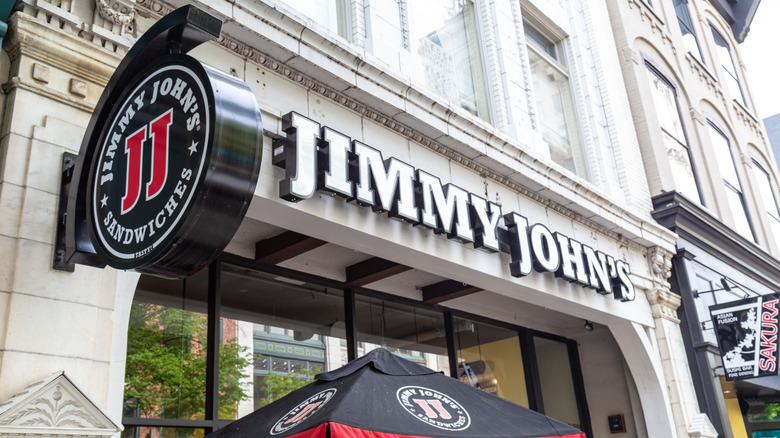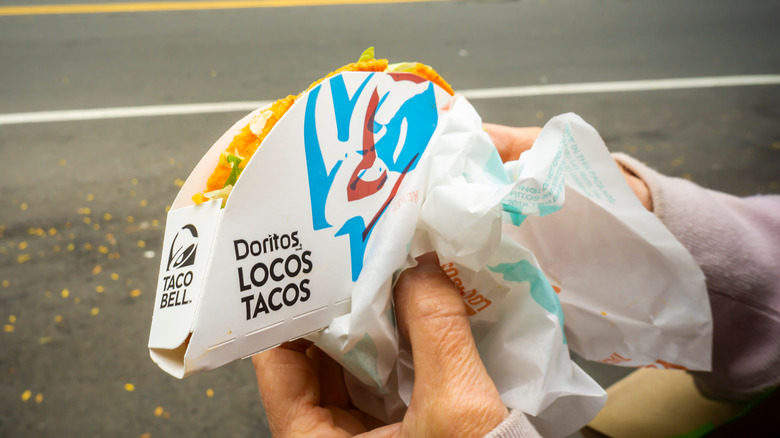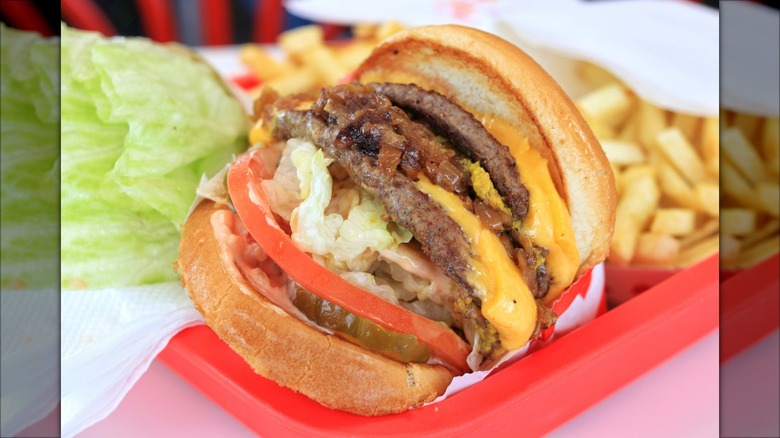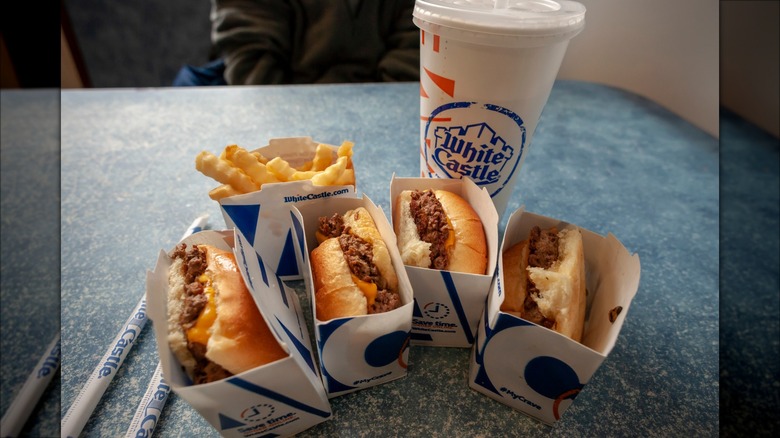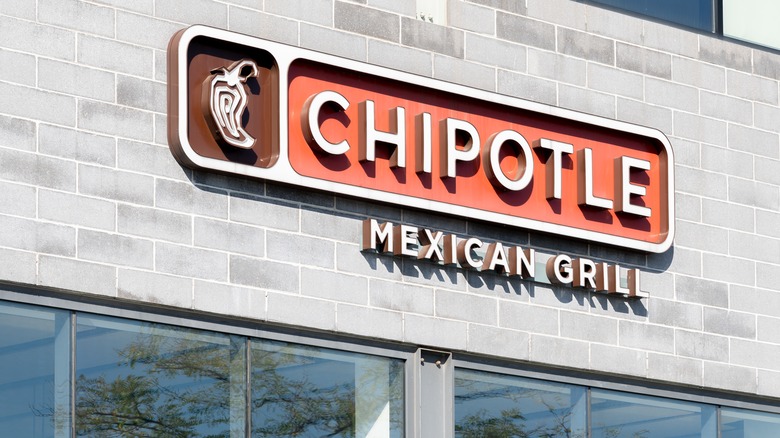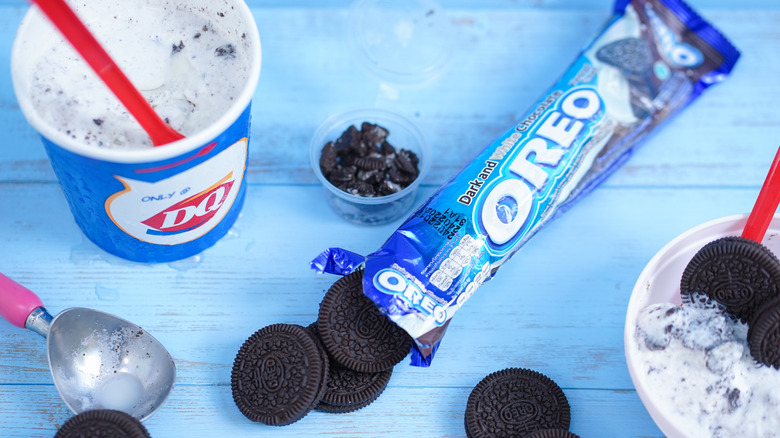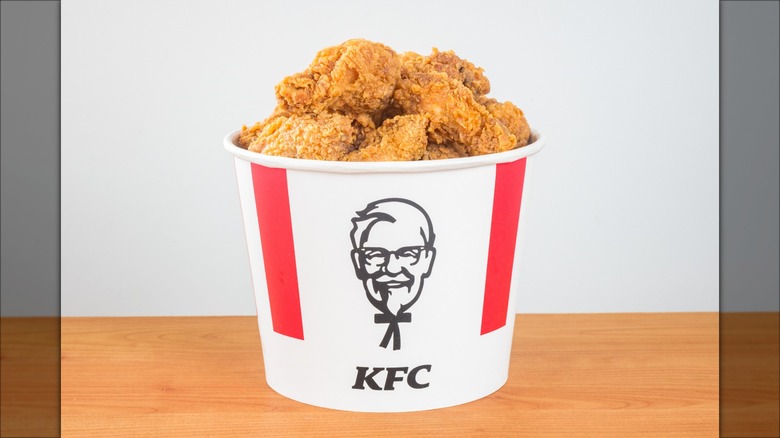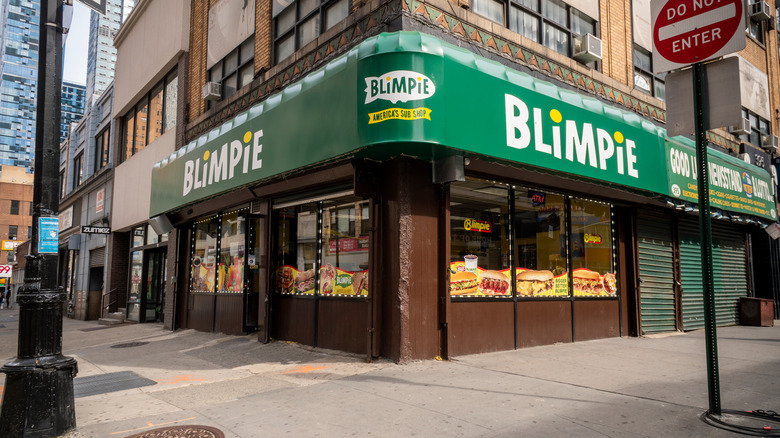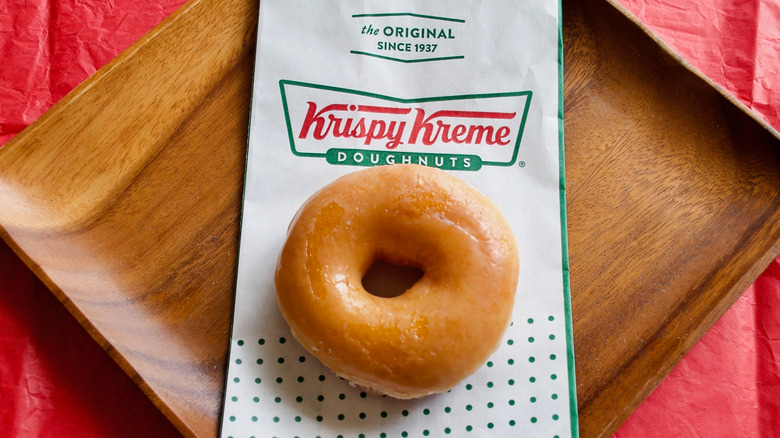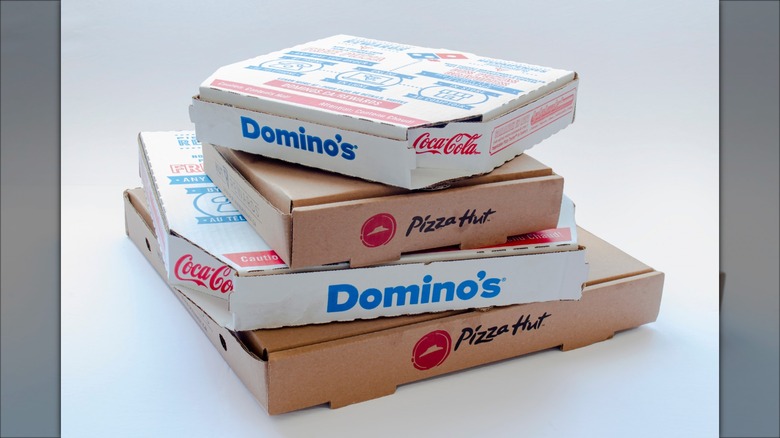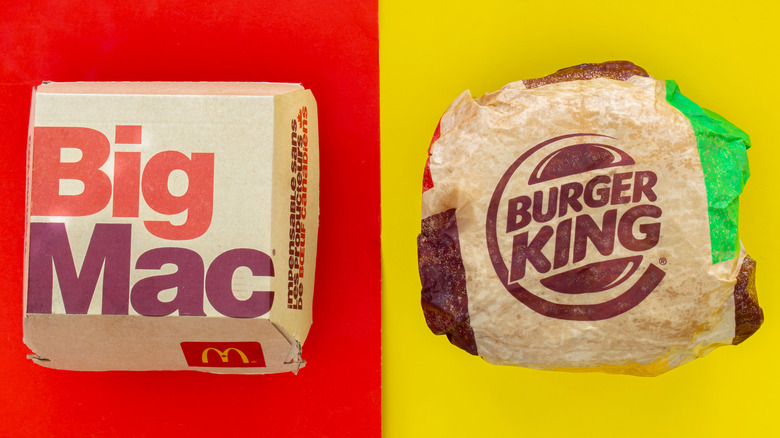The 12 Biggest Fast Food Rivalries, Ranked
Fast food rivalries have been around as long as fast food itself. We mean that literally, as there's even a rivalry regarding who came first. According to Smithsonian, White Castle is commonly accepted as the first fast food restaurant, making its debut in 1921. However, the restaurant chain and soft drink company A&W — which started the practice of franchising in 1925, per their website — began life as a roadside stand in 1919, giving them an argument as the first-ever fast joint to appear on the American landscape.
It's no surprise that countless quick-service food rivalries have sprung up since. Some of the best fast food rivalries have been close affairs, while others were one-sided from the get-go. Some companies have taken public aim at each other — for instance, how Burger King and McDonald's have traded barbs through their respective advertising campaigns — while other rivalries have been more subtle (via Forbes).
Either way, to say that eateries have battled for first place when it comes to both the hearts and stomachs of consumers ultimately rings true. Some rivalries can even be mentioned in the same breath as Coke versus Pepsi, Microsoft versus Apple, Ford versus Chevrolet, and other legendary brand clashes. Let's look at the 12 biggest fast food rivalries in history and see where they stand.
12. Zaxby's vs. Bojangles
The feather-flicking battle between Zaxby's and Bojangles is a study in Southeast chicken. Both almost exclusively serve chicken-based entrees on their menu, making how it's served the crux of this rivalry. Bojangles is most known for its homestyle fried chicken, while Zaxby's focuses on chicken fingers, wings, and sauces. Both also serve chicken sandwiches and salads in addition to other fare — though notably, Bojangles has gained wide notoriety for their biscuits. (As Inc. noted in its obituary for co-founder Jack Fulk in 2011, sales increased by 60% after Bojangles first introduced biscuits to their menu.)
The rivalry between Zaxby's and Bojangles is practically neck-and-neck in terms of geographic locations and numbers, and it seems it's been that way from the very beginning. The franchises were even founded less than four hours away from each other, though more than a decade apart. According to Zippia, Bojangles was born in 1977 in Charlotte, North Carolina, while the first Zaxby's opened in 1990 in Statesboro, Georgia, per the company's website.
Both restaurants are also pushing outward from their Southeast roots. Bojangles now stretches as far north as Pennsylvania, and in 2021, they announced plans to open 15 stores in the Columbus, Ohio area, as local affiliate ABC6 News reported at the time. In 2020, Goldman Sachs purchased a stake in Zaxby's, which included plans for further expansion (via the Statesboro Herald). It seems there isn't an end in sight to the feud between these two fried chicken chains.
11. Subway vs. Jimmy John's
It might seem like Subway, the franchise known for its footlongs, doesn't have a true rival — but their main competitor, Jimmy John's, would beg to differ. After all, both tout menus that feature submarine sandwiches and wraps, and both also stress the freshness of their ingredients in their marketing. Subway has used the ubiquitous "Eat Fresh" slogan since 2000 (via MarTech). In a kindred vein, Jimmy's Johns ads, such as their (sometimes cheeky) "Freaky Fast, Freaky Fresh" ad campaign, communicates more or less the same. The most significant difference has long been that every Subway meal is customizable, while the Jimmy John's menu is fixed. Subway, however, introduced a series of sandwiches in 2022 that customers could order as-is, according to Business Insider.
Although Subway is one of the world's largest fast food franchises, its lead over Jimmy John's is shrinking. According to Statista, the number of Subway locations in the U.S. fell from 27,103 to 21,147 between 2015 to 2021 — a staggering 22% drop. This decline aided in dubbing Jimmy John's the sandwich king's closest challenger with more than 2,700 locations in 45 U.S. states (via ScrapeHero). It also paved the way for Inspire Brands, an umbrella company owner of chains like Buffalo Wild Wings and Arby's, to purchase Jimmy John's in 2018, per QSR.
Despite this, Subway's reign has remained solid. A 2019 YouGov survey found that Subway is still America's favorite sandwich shop. Jimmy John's has work to do as they ranked a distant fourth, trailing fellow competitors Jersey Mike's and Schlotzsky's.
10. Taco Bell vs. Del Taco
The irony of Taco Bell and Del Taco's rivalry today, one could argue, is that both franchises share the same origin story. Shortly after businessman Glen Bell opened Bell's Hamburgers in 1953, he hired a man named Ed Hackbarth to work there (via the Baltimore Sun). Bell then experimented with several other restaurants before coming up with his crown fast-food achievement — you guessed it, Taco Bell – which opened for business in 1962 in Downey, California, per the Taco Bell website. Two years later, Hackbarth used the knowledge he gained from working for Bell — which, most importantly, included his recipes, according to the Daily Press — and established his own franchise, Del Taco, in nearby Yermo, California. (A Shakespearean fast-food feud for the ages, no?)
Since then, the two restaurant chains have had vastly different trajectories. According to parent company Yum Brands, Taco Bell is the undisputed sultan of fast food tacos, with more than 7,000 locations in the U.S. alone. Del Taco, on the other hand, has roughly 600 locations spread across 16 states. Then again, it's not for lack of trying on Del Taco's part. Per the Los Angeles Times, the taco franchise first attempted to expand nationwide in the 1990s; more recently in 2021, Del Taco announced plans to open new franchises in Ohio, Virginia, and North Carolina, as the Washington Business Journal reported at the time. With fellow fast food chain Jack in the Box purchasing Del Taco in March 2022, they now have more resources to challenge Taco Bell (via Nation's Restaurant News).
9. Whataburger vs. In-N-Out Burger
While the fast food rivalry between Whataburger and In-N-Out Burger may be regional in nature, its intensity is super-sized. These burger joints — which Business Insider notes have respective, almost cult-like followings — have been on a "better burger" collision course practically since day one. According to their website, In-N-Out Burger went into business in 1948 in Baldwin Park, California, while the first Whataburger opened two years later in the Texan city of Corpus Christi. Both chains are inexorably linked to their home state (to quote Business Insider, "Whataburger is to Texas what In-N-Out is to California"), and residents swear by their respective state-affiliated favorites.
Notably, it seems In-N-Out Burger and Whataburger's rabid fanbases are entirely due to the quality of their food. Whataburger says they make every burger using "100% pure, never-frozen beef," and for its own part, In-N-Out requires new locations to be within a day's drive of a company warehouse to keep ingredients fresh (via Forbes).
So who reigns supreme? Based on numbers, Whataburger leads the way. According to ScrapeHero, they currently sport more than 900 locations in the South and Midwest, while In-N-Out has just under 400 locations throughout the Southwest, as ScrapeHero also notes. The rivalry goes head to head in Texas, Arizona, and Colorado with both competing for the affections of burger-lovers. So far, appetites seem to favor Whataburger, as they ranked ahead of In-N-Out in USA Today's 2021 survey of the top 10 best regional fast-food chains in the U.S.
8. White Castle vs. Krystal
When it comes to tiny fast-food hamburgers, White Castle and Krystal are the two biggest franchise names in the U.S. — with sliders at the core of their rivalry. USA Today notes the main difference between both chains is that Krystal offers fried burgers that are truly in miniature. Conversely, White Castle sliders are steam-grilled instead of fried, which in turn gives them a distinctive texture.
The region-based fast food rivalry between these mini burger hotspots is one of the closest out there — but seldom goes mano-a-mano. According to Smithsonian, White Castle, which opened in 1921 in Wichita, Kansas, is concentrated in the Midwest and New York City metro area. On the other hand, Krystal was established in 1932 in Chattanooga, Tennessee, and is still largely known almost exclusively to Southerners. Based on digital data published by Rentech Digital in 2021, this still seems to be the case as of this writing.
Why haven't we seen more expansion for either slider chain? In the case of Krystal, it boils down to financial difficulties. As USA Today reported in 2020, the franchise was forced to file for Chapter 11 bankruptcy that year due to "shifting consumer tastes and preferences, growth in labor and commodity costs, increased competition, and unfavorable lease terms," according to their now-former chief restructuring officer Jonathan Tibus. Unlike Krystal, franchising issues for White Castle aren't a thing. The company doesn't offer franchising at all, and its restaurants are exclusively located near its raw material facilities.
7. Chipotle vs. Moe's
The rise of fast-casual burrito hotspots has spawned an intense rivalry between Chipotle Mexican Grill and Moe's Southwest Grill. Both are relatively new kids on the restaurant block — per CNBC, Chipotle was founded in 1993, while Moe's first opened its doors in 2000, according to its website. But what this rivalry lacks in longevity it makes up for in fierceness. As Business Insider notes, their respective customer bases feel the same way: "Some vow never to walk in a Moe's, while others hold a particular disdain for the ever-present Chipotle."
A big part of the rivalry between Moe's and Chipotle has to do with their similar menus. Eater notes the burrito style at Moe's appears to copy that of Chipotle, and each also offers quesadillas, tacos, nachos, and other Tex-Mex offerings. However, their personas are vastly different. Chipotle stresses "being real" and their commitment to using local organic ingredients. Meanwhile, Moe's is known for an offbeat attitude: According to their website, they acknowledge many of their menu item names are pop culture references, and the restaurant's name is an acronym for "musicians, outlaws, and entertainers."
As for who rules the ring, it appears to be a split decision. Restaurant Magazine reported that a 2012 Market Force survey named Chipotle America's favorite Mexican quick-service chain. However, a 2016 Harris Poll survey detailed by USA Today declared Moe's U.S. champ. In 2019, Market Force gave the title back to Chipotle by a one-point margin over Moe's, showing just how close the rivalry is (via Restaurant Dive).
6. Dairy Queen vs. Carvel
For decades, Dairy Queen and Carvel have been satisfying America's sweet tooth, and their rivalry stems from their shared status as pioneers in soft-serve ice cream. As Smithsonian notes, both have even gone as far as to claim to have invented it. Based on the official historical timelines, it appears Carvel gets the nod as "first." Carvel notes on their website that their founder, Tom Carvel, patented his method for making soft serve in 1936, while DQ founders J.F. and Alex McCullough developed their version in 1938 in Kankakee, Illinois, according to their local newspaper, the Daily-Journal.
Despite being second off the starting line, DQ has since enjoyed a one-way trip to the top. Since Dairy Queen first opened in 1940, it has expanded to more than 7,000 global shops and 4,300 in the U.S. alone (via ScrapeHero). Dairy Queen's vision now goes beyond ice cream, thanks to DQ's "Grill and Chill" meal-and-dessert concept, which played a big role in growing the brand, according to strategist firm SLD.
According to The New York Times, Carvel was a legit challenger for DQ for a long time, with 865 stores in 1985, a period Funding Universe claims was Carvel's de facto golden age. However, as of 2022, the number of Carvel locations has experienced a decline, with just over 320 locations in operation, with more than half of them grouped in New York state. Despite this, Carvel is still well-known for its ice cream cakes, with Carvel's mascot Fudgie the Whale ingrained within American pop culture (via the New York Post).
5. KFC vs. Popeyes
When it comes to Southern-style fried chicken, Kentucky Fried Chicken (otherwise known as KFC) and Popeyes are the world's clear No. 1 and No. 2 — so a rivalry is only natural. While the menus for each are nearly identical at first glance, Popeyes and KFC have historically gone to great lengths to differentiate their fast-food staples and specials. Their shared approach? Highlighting their signature blends and flavors by way of respective marketing campaigns — all the while ruffling each other's feathers.
Many might be aware that KFC is all about its top-secret blend of 11 herbs and spices — and as NBC News has noted, the company goes to great lengths to keep this secret. Meanwhile, Popeyes is known for going all in with Cajun-style seasonings, and transparently so: After much anticipation, former CEO Cheryl Bachelder revealed in a 2015 interview with the Associated Press that the franchise uses an egg-and-flour batter to make its chicken crispier (via Fox Business).
In terms of reach, the feud between both fried chicken franchises has more than once crowned KFC as the king rooster. Statista data from 2021 put KFC at almost 27,000 franchises worldwide that year; meanwhile, Statista's data also counted 3,400 Popeyes locations globally. Even so, Popeyes is still pecking away, officially expanding into the U.K. in 2021.
4. Subway vs. Blimpie
Younger readers may not realize Subway and Blimpie, a now lesser-known submarine sandwich chain, were once fierce rivals. Indeed, it was Blimpie, not Subway, who paved the way for the fast-food hoagie market: Blimpie opened its first shop in 1964, while Subway followed suit in 1965. Despite this, Subway soon gained a big early lead — so how did that come about in the first place?
It seems that ownership played a big part. According to the Subway website, franchise founders Peter Buck and Fred DeLuca had a clear vision for the restaurant, with the clear goal of expanding to 32 stores within their first decade of existence. Conversely, according to Reference for Business, Blimpie co-founders Tony Conza and Peter DeCarlo disagreed over expansion plans; this friction caused Blimpie to split in 1976, with each founder controlling the rights in different areas.
But it didn't stay that way. In a piece he later wrote for Inc., Conza shared that the chain went from 275 restaurants in 1987 to more than 2,000 in 1999. According to Conza, this was achieved through nontraditional franchising, like opening locations in convenience stores and mall food courts. (It's a model that many other fast-food chains since have copied — including Subway.) But Blimpie's success only held out for so long. Rentech Digital data from 2021 says the franchise only counted 149 U.S. locations that year — a drop of more than 90% from their peak years decades prior. Compared to Subway's 37,000 stores worldwide, Blimpie has more or less been knocked out of the ring (via Statista).
3. Dunkin' vs. Krispy Kreme
Want a donut? For decades, Dunkin' and Krispy Kreme have been the top two choices for Americans who vie for a frosted round pasty on the run. Donuts were (and are) so vital to their separate business models that the word itself was part of the original names for both companies. In order to compete with one another, each business took on a distinct take on donuts.
Insider notes Krispy Kreme is known for its iconic glaze, which originated as part of a recipe purchased from a New Orleans chef. Dunkin' instead seemingly went the route for sheer variety, claiming they sell more than 50 different types of donuts in their many locations. Over the years, Dunkin' has ballooned to more than 13,000 locations worldwide as of 2019, per Statista. Comparatively, Krispy Kreme's reach is minimal at about 1,400 stores, according to Investor's Business Daily, Krispy Kreme has about 1,400 stores.
So what happened? Perhaps it goes beyond donuts. in a 2015 interview with CNBC, former Dunkin' CEO Nigel Travis said about 60% of company sales were derived from their beverages. At around the same time, the Charlotte Business Journal reported that Krispy Kreme's made up only 13% of their revenue. But if you're a Krispy Kreme loyalist, don't worry too much about the disparity in franchises — according to Investor's Business Daily, Krispy Kreme donuts are also sold in about 12,000 retail stores, keeping them well in the game.
2. Pizza Hut vs. Domino's
Few food rivalries have been more ferocious than the one between Pizza Hut and Domino's. These massive pizza chains were founded within two years of each other, with Pizza Hut opening its first location in 1958 and Domino's in 1960. Together, they fueled America's appetite for pizza and grew at a torrid pace — both companies say it took them less than 30 years to reach 5,000 locations.
For decades, Pizza Hut was unchallenged as No. 1. Back in 1995, Pizza Hut had 25% of the pizza market share compared to 11% for Domino's — a more than 2-to-1 edge (via Louisville Business First). As detailed by The Hustle, innovation spurred Pizza Hut's dominance, with items such as the Hut's pan pizza, stuffed crust pizza, and Big New Yorker introduced at a constant pace and welcomed with big bumps in sales for the company.
But the story of their battle for the top eventually took a turn. The shift began when Domino's launched its "Pizza Turnaround campaign in 2010," which involved implementing a new pizza recipe, attractive value offerings, and new ways to order a pie, including through social media (via CNN). Unlike Domino's, The Hustle notes that Pizza Hut's famed flare for innovation has seemingly stagnated. This appears mostly due to the perception that would-be customers "don't associate Pizza Hut with delivery" — which is a pretty significant problem in a mobile world (via CNBC). As a result, CNBC reported that Domino's captured the total sales crown in 2017, and on the whole has ever since.
1. McDonald's vs. Burger King
In the annals of fast food rivalries, McDonald's versus Burger King is the biggest beef of all, and it's been that way since the beginning. According to the Arts Tribune, Burger King co-founders Keith J. Cramer and Matthew Burns were inspired to launch their own foray into fast food after visiting the original McDonald's. Thus Burger King was born in 1953 — and the greatest fast food rivalry in the history books along with it.
What truly sets this feud apart is how the burger chains constantly target one another in marketing, products, and even staffing. When McDonald's rolled out their famous Big Mac ad jingle naming each ingredient, Marketing Dive notes that Burger King countered with the "Have it Your Way" slogan. When Burger King was looking for a spark in the late 1970s, they hired Donald N. Smith away from McDonald's as their new CEO (via The New York Times). And as The Street explains, if one chain launches a successful menu item, the other usually adds a copycat version. For example, as The Augusta Chronicle noted in July 1997, McDonald's played off the Whopper's success by rolling out the almost-identical Big 'N Tasty. Just a month later, Burger King countered by announcing a Big Mac imitation called the Big King (via The Spokeman-Review).
Through it all, McDonald's has remained No. 1 by every measure. As of 2019, McDonald's had 21.4% of the global fast-food market share, while Burger King had just 1.16% — a more than 18-to-1 gap. Nevertheless, the rivalry has had a lasting impact on the fast food landscape.
